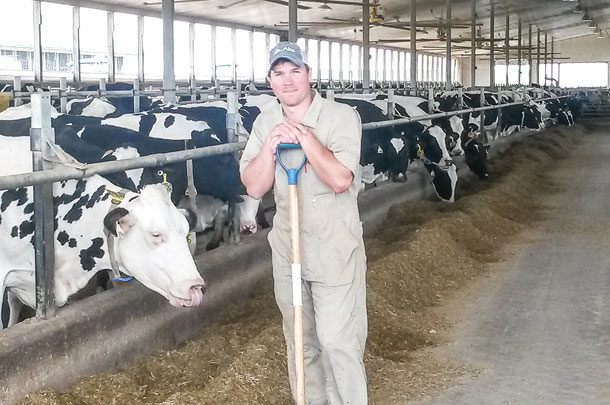For their feed program, they keep it to one milking cow ration, once-a-day feeding, buying bulk commodities and making good-quality forage.
Brad Whytock, dairy specialist, Grand Valley Fortifiers Ltd, has been working with the farm for the past two-and-a-half years, but the farm has been with the company for more than 20 years.
Tyler Kuntz says the farm’s main purchase is a mineral pack, as they prefer to buy their other ingredients – like dry corn, distillers grains, cottonseed, soybean meal and canola meal – in bulk and then mix everything together on the farm.
Buying in bulk allows Kuntz to book feed purchases six months to a year ahead of time. “If something is low, I’ll book in advance,” he says. “It’s easier to take advantage of price.”
They grow all of their own forages, straw and grains. By using this method, they have the flexibility of switching proteins and minerals as needed.
“We can adjust the ration as need be depending on how good the forages are and the protein I can get on the farm,” Kuntz says.
Click here to view a diagram of the milking-cow ration at Ikendale Farms Ltd. (PDF, 643KB)
This causes the farm’s ration to be similar to how Whytock works with very small herds. Small tweaks can be made on-farm because there are separate products versus a complete mix. Those tweaks are made an estimated 20 times a year. The farm sends off forage samples once a month and will adjust the ration based on those results.
Whytock also stops by the farm once a week, normally on Wednesdays, to check milk production, monitor cow activity, walk the barns, take manure scores, run a Penn State shaker box test and check body condition scores.
If Whytock, Kuntz or the herd manager sees something out of place, a ration change will be made. It could be anything from manure being too hard or too soft, too much corn on the screen, the milk tank going down or cows’ feet being sore, to prompt a change.
While those small adjustments are made, the overall philosophies remain the same. Kuntz joined the farm after graduating from the University of Guelph in 2004. He farms full-time with his father, uncle and brother and says, for the most part, things have stayed the same in the past 11 years.
They feed a single milk cow ration, a close-up dry cow ration and a far-off dry cow ration. Cows are dried off at 50 to 60 days before calving and moved to the maternity pen 21 to 30 days before calving when they receive their close-up ration.
Kuntz says they ran into some problems this spring with cows not transitioning well. They were seeing more ketosis, displaced abomasums, milk fevers and retained placentas – and couldn’t quite put a finger on it.
He adds, “5 percent DAs would be a nightmare on our farm. If we get even 1 or 2 percent DAs, we’re getting things figured out.”
The farm’s herd manager has been there for 20 years and keeps excellent records. “With his good record-keeping we can pinpoint a problem very quick,” Kuntz says. “It is so valuable when you have a problem.”
Once a problem is identified, they will call in their nutritionist or veterinarian to help resolve it.
“Herd management is their strong point,” Whytock says. “Good management really brought them to where they are at.”
The transition problem resolved when they ran out of third cutting from last year and started feeding this year’s first cutting. “The problems pretty much went away,” Kuntz says. “We attributed it to the third cut last year, but on paper and intake-wise, we don’t actually have a reason.”
Whytock mentions the farm struggles with feeding third-cut haylage. “It does not respond the way we expect,” he says.
The farm does place an emphasis on producing high-quality forages and will stress quality over yield, he adds.
Forage is a mainstay in the ration, but the push for a high-forage diet changed after Kuntz read the article, “The Myth of High-Forage Diets” in our April 2015 issue of Progressive Dairyman – Canada (Vol. 5 No. 4).
He says, “I always liked the idea of feeding more forage because it seemed natural and healthy. Cows are ruminants – they like grass, they like forages – but maybe I’m not meeting her demands, maybe I do need some grains, some oils, some proteins.”
He no longer worries about being at 70 percent forage and 30 percent concentrates. “If the ration is 55 percent forage, 45 percent concentrate, I’m OK with that if that’s meeting the cows’ needs,” Kuntz says.
They also find a single milk cow ration is suitable for the entire herd. At one time they had a low-, medium- and high-production ration, but now that production has increased, and days in milk are right around 150 to 160, all of the cows get the “high” ration.
With a 40-litre milk average and 3.8 fat, the cows are giving back what Kuntz is putting into them. “Even when costs go up, I seldom cheapen out on that cow. They do so much for us,” he says.
That is a philosophy Whytock supports. He understands that at the end of the day, profit for the farmer is number one, but he believes a focus on healthy cows that calve in well and breed back is the key to good milk production and profits.
He says the Kuntzes are a great group of producers to work with. Milk production has increased 5 litres per cow in the last three to four years, and he credits that with the farmers’ ability to listen and learn. PD
PHOTO: Tyler Kuntz finds buying bulk commodities helps to keep his feed program flexible. Photo provided by Ikendale Farms Ltd.

-
Karen Lee
- Editor
- Progressive Dairyman
- Email Karen Lee










